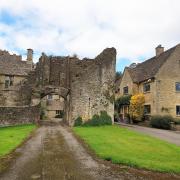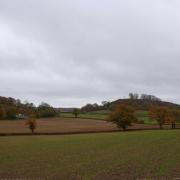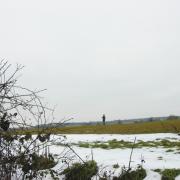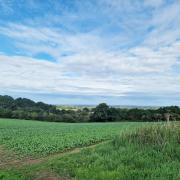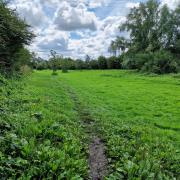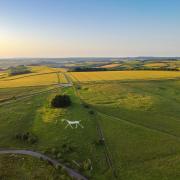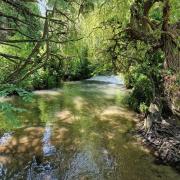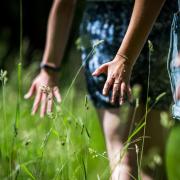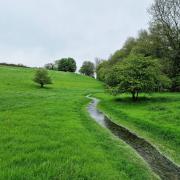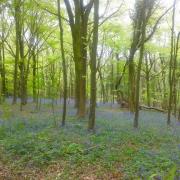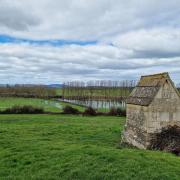In our latest literary ramble, we explore the golden backlanes of this pretty Cotswold town

Discover the picturesque Cotswold town of Nailsworth with its enticing boutiques, beguiling backlanes, and bracing views, as you roam in the footstep (he had a wooden leg) of ‘supertramp’ poet, WH Davies. Visit his old cottage and enjoy ‘standing and staring’ at the splendid vistas from up on Minchinhampton Common, before repairing to The Old Lodge or Hobbs House Bakery for a warming drink and hearty victuals.
Above the steep market town of Nailsworth along the charming lane to Watledge there lived a poet whose work is still cited by memory to this day. Welsh poet and writer, William Henry Davies, was born in Newport, 3 July 1871, the son of an iron-moulder. His best known prose work is The Autobiography of a Super-tramp (1908), which relates his colourful adventures travelling around North America with the likes of such ne’er-do-wells as Three Fingered Jack. It was while hopping freight cars with Jack during the Klondike Gold Rush that Davies slipped and lost his right foot.
Incredibly, this did not dissuade him from his wanderings, and he continued his long walks both in America and back home, settling in Nailsworth, where he lived with his wife, Helen. He moved in a circle which included the Sitwells who lived in nearby Nether Lypiatt, and Edward Marsh, who included him in an era-defining anthology of Georgian Poetry.
Fellow poet Edward Thomas was a great supporter and friend. Davies wrote of the natural world, with which he had deep acquaintance, life’s hardships and simple pleasures. His best known poem is ‘Leisure’, which starts with the immortal lines: ‘What is this life, if, full of care/ We have no time to stand and stare.’ Good advice! Davies died on 26 September 1940 in Nailsworth, aged 69. Glendower Cottage, his final residence in the town, is slowly being restored by The Friends of Glendower. It is hoped that it will eventually become a centre dedicated his life and work.

The walk:
1. Park behind the Nailsworth Library. In the library there is a display about WH Davies. Above the town to the north there is a ridge of trees – where you’ll be heading, so gird your loins!
2. Cross over Old Market at the pedestrian crossing. There are toilets here if you need them, otherwise turn right and then head across to the little stone bridge which crosses the stream just behind the bus-stands. Cross the brook.
3. Heading left, walk through the small park, until you emerge onto the main road (A46). Turning left you go past some lovely shops. The Yellow-Lighted Bookshop should be able to help if you want to pick up some WH Davies poetry to read out along the way. But resist retail therapy if you can (until later)! Cross over the road at the pedestrian crossing. Head towards the town clock and turn right, up George Street.

4. Ahead you’ll see Hobbs House Bakery, which might tempt you in with its delicious smells. If you stop for snacks here, you can always eat a take-away pastry or pasty by the town’s war memorial clock.
5. Proceed up the hill of George Street, past the giant copper kettle. Pass through the white wooden gate by the cattle grid.
6. Turn left at the sign for ‘Watledge and ‘Theescombe’, by an old well, dated 1858.
7. Proceed along Watledge Road, pass the old Shears Inn on your right. You walk by some lovely houses here, and, if you’re lucky, the honey-coloured Cotswold stone will be lit up by the sun, make it glow. Even if it isn’t a sunny day, you’ll soon come to a golden postbox, celebrating the 2012 Olympic gold medal of world class rower Pete Reed.

8. Keep going until you get to Glendower Cottage, where there is an inscription to WH Davies. This is a good place to read out some of Davies’ poems, in particular ‘Leisure’.
9. Just past Glendower and Newton Cottage turn right up a public footpath, passed the phone box, then right when it hits steep Whips Lane, walking up the hill as it becomes a rubbly track. Before you leave the houses behind note the blue plaque on the right, at Spring Cottage, dedicated to a young First World War lieutenant.
10. Proceeding up the steep and narrow track following the line of a dry-stone wall. You’ll have a nice view on your left, over to Woodchester and the wind turbine above Thistledown, towards the Cotswold escarpment in the west. If it’s early spring, there might be some snowdrops along here and even some lambs in the adjacent field. This would be a good moment to read Davies’ powerful poem, ‘The Dumb World’, which is his cri-de-coeur for animal rights.
11. As the path reaches a pretty row of cottages, at Pinfarthings, take the road to the left, past Cedar Cottage, up the hill to Minchinhampton Common.

12. Ascend to the common up the diagonal path. Stop on the brow, turn around to enjoy the view you have earned. Turn left, following the edge of the hill. On your right you’ll eventually see the white gable of The Old Lodge. Turn right across the golf course, head towards it (watch out for golf balls!).
13. Arrive at The Old Lodge. Time for refreshments!
14. Departing The Old Lodge, retrace your route across the golf course (follow the telegraph wires) back to the brow of the hill. Follow the footpath left, heading towards the trees in the distance.
15. You’ll eventually come to the back of Beaudesert School. Follow its perimeter wall along until you get to the road. Cross carefully, heading down the lane opposite.
16. Move passed the cottages (Leylands) down the hill. Follow the sign for Scar Hill.
17. Stay on the lane as you pass the Box Wood (there is an optional detour through the trees – check the interpretation board for the route – but mind your step as it might be muddy and slippy).
18. When you get to the bend in the lane you have a choice to follow the narrow path between Hermitage Cottage and the woods. Turn left. This will eventually come out on a level lane. Turning right it will pass the front of the handsome houses and rejoins Scar Hill.
19. You are now on Pensile Road. Follow this along and you’ll pass some impressive crags.
20. Keep going until you reach the town, by the cattle grid, below the W of the ‘Devil’s Elbow’. Turn left back into town and to your car, bus or bicycle! Bravo!
Kevan Manwaring is a Stroud-based writer and storyteller. He is the author of Oxfordshire Folk Tales and Northamptonshire Folk Tales, a contributor to English Folk Tales and editor of the forthcoming Ballad Tales, all from The History Press. He teaches creative writing for the Open University and in the Stroud-area.
For those who love rambling the Cotswold countryside, follow Kevan’s route around Dumbleton, one of our autumn or winter walks or perhaps one with a pub en route?






